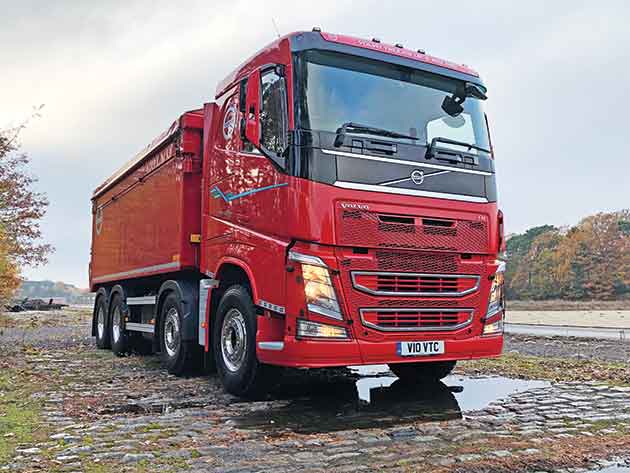
For those in bulk haulage who cube out before weighing out there is a chance to specify a little extra to the wagon to make life easier, like Volvo’s dual clutch. In the idyllic terrain of the Borders, Kevin Swallow got to grips with a stylised FH tipper.
‘BESPOKE’ best sums up the tipper market. No two operator’s specification and rolling stock are alike. From the driveline to the cab to the bodywork; it’s design and specification can often be traced back through the generations.
For Transport News, Volvo Trucks entered into the ‘made to order’ spirit with its Volvo FH B-Ride N3, to give it its full title. Central to its uniqueness is the dual clutch. First launched in 2014, and said to be inspired by motor racing gearboxes, it is set up to provide the driver with split second precision gear changes up and down the box.
For those born from necessity and hell bent on getting every last ounce of payload onboard, look away now.
The dual clutch costs the best part of £4,000 and weighs 101kg more than a standard clutch I-Shift gearbox.
Welcome back.
The SPO2812 gearbox is an overdrive transmission that uses two dry clutches located at the front of the gearbox, one for odd numbered gears and the other for even. As one clutch is engaged the other idles and will pre-select the next gear while driving in the current gear.
When a gear change is made the engaged clutch is released at the same time as the previously idling clutch is being engaged. This means that the gear shifting is made with no interruption in power delivery with the exception of when it changes through the range gear between sixth and seventh.
It’s arrival five years ago cemented Volvo’s place in the vanguard of automated transmissions. Since then the arrival of ZF’s TraXon has helped truck manufacturers like DAF, Iveco and MAN to close the gap and Scania’s Opticruise is also slick.
For this test Volvo has specified its 8×4 chassis with a Globetrotter cab, and the 12.8 litre D13K460 that uses electric unit injection to deliver fuel to the six cylinder engine, and not the common rail generally preferred by competitors.
Euro 6 is met with a combination of mild exhaust gas recirculation (EGR) at 10% that requires no EGR cooler, with the rest of the work done by selective catalytic reduction (SCR).
The D13K is available in four ratings; 420, 460, 500 and 540hp. For this test we have the 460, although the engine produces a true rating of 453hp from 1,400 to 1,800rpm while 2,300Nm peak torque is delivered from 900 to 1,400rpm.
Turning power into motion is the SPO2812, 12 speed I-Shift dual clutch transmission. You can order it with the 460, 500 and 540hp engines. This spec has an overdrive top gear rating of 0.78:1, which helps to bring down the revolutions of the 3.08:1 rear axle ratio that Volvo has duly specified.
For mainly road going activities this eight legger is set up with the cranked front axle, which provides a 14° ground clearance under the front bumper. With the straight beam favoured for more off road activities, its 16°. Specify a cranked axle and you’ll save 100kg on the 5,100mm wheelbase.
The chassis height for this particular truck is high, which is around 1,000mm, compared to X-High at 1,200mm, medium at 900mm and low at 850mm.
And finally, it also has the Volvo Dynamic Steering (VDS). I am a big fan of this, as it makes life a lot easier for the driver. Launched in 2013, it is designed to stop drivers wrestling with the steering wheel as they squeeze the wagon into a tight space at low speeds.
Using an electric motor connected to the steering gear it receives information from several sensors. The motor is controlled 2,000 times every second using a torque overlay to correct unintentional steering movements and to provide extra torque when needed. When you gather speed the steering stiffens.
Considering how much the manufacturer tells you how quick the gearchange is, you’d be forgiven for thinking that the six or seven changes that are made en route to 50mph would put Lewis Hamilton to shame.
Some gear changes are really drawn out, especially if the driver has control of the accelerator. In fact, as the driver you can change gear much quicker yourself.
Drawn out changes tend to take the edge off of the driver’s ambition to crack on, almost imploring the driver to relax. It is only when demand is placed on the driveline as the truck climbs and needs a lower gear that extra money and weight is justified.
Climbing Carter Bar on the southbound A68 from Scotland into England the changes were sharp and unequivocal, and done with the nonchalance of a blink of the eye, safe in the knowledge it won’t miss a thing. It is then you realise just how good the dual clutch is.
For tipper work, the Globetrotter might appear to be a little over the top even without the Drive++ option for the interior. Globetrotter is lighter than the Globetrotter XL but it adds 40kg compared to the entry level sleeper cab.
Globetrotter has a 1,960mm standing space over the engine tunnel, and there is a 90mm drop into the footwell. This compares favourably for taller drivers vis-a-vis the standard sleeper cab that has a standing height of 1,620mm over the engine tunnel.
As a one bedroom open plan studio on wheels the Globetrotter is spacious enough to relax in, making it a decent alternative to the Globetrotter XL.
It does not lack for creature comforts with the Drive++ cab trim level and ‘1 Bed’ package. The dark leather, air suspended drivers’ seat is a good option. It has the media navigation pack, Active Safety+ and ‘visibility’ package, which is a camera system.
It has plenty of storage above the windscreen and on the back wall, a comfortable bunk and enough space to actually walk between seats and bunk. Overall, it makes for a stylised cab interior.
The focus on this road test was without doubt the dual clutch. Tippers that are run competitively should spend most of their time fully laden, so having the ability to grab a quick gearchange under duress is a real benefit.
Throughout this test, fully freighted at 32 tonnes, the gear changes were fast enough to back up Volvo’s claim that it doesn’t affect the power and torque delivery while working.
It does certainly make for a smooth ride, and that is also down to the fuel friendly software packages that adapt the gear changes to the prevailing transport conditions.
In the end an operator has to choose what is the best specification for the work that they do. If the truck is not weight dependent, then there are added extras that can make a lorry driver’s life much easier.
If weight is an issue then I’d favour the dual clutch at the expense of the Globetrotter cab and I’d choose a smaller fuel tank and even shorten the wheelbase to compensate.
I’d take the VDS to make manoeuvrability better for the driver and try to lose a little bit more weight from the bodywork. Either way, as this road test demonstrates, specification can be as bespoke as you want it.




